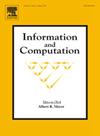下推式和单计数器自动机:恒定和非恒定内存使用
IF 1
4区 计算机科学
Q3 COMPUTER SCIENCE, THEORY & METHODS
引用次数: 0
摘要
无法确定单计数器自动机是否使用计数器接受其语言中的每个字符串,该计数器的值相对于输入的长度有一个常数的限制。此外,当计数器以常数为界时,它的值不能受到机器大小中的任何递归函数的限制。通过考虑所有计算的代价(强度量)或所有接受计算的代价(接受度量)而不是最便宜的接受计算的代价(弱度量),上述问题对于下推自动机和单计数器自动机都是可决定的,而下推高度的边界或计数器的值在非常数时,在机器的大小上是递归的。我们还证明,在弱测度下,如果一个单计数器自动机接受一个相对于输入长度不受任何常数限制的计数器,则该计数器至少以对数函数的形式增长。这与下推自动机的情况相反,下推自动机的边界是一个双对数函数。对于强测量和接受测量,对于下推自动机和单计数器自动机,这些边界被证明是线性的。本文章由计算机程序翻译,如有差异,请以英文原文为准。
Pushdown and one-counter automata: Constant and non-constant memory usage
It cannot be decided whether a one-counter automaton accepts each string in its language using a counter whose value is bounded, with respect to the length of the input, by a constant. Furthermore, when the counter is bounded by a constant, its value cannot be limited by any recursive function in the size of the machine.
By taking into account the costs of all computations (strong measure) or of all accepting computations (accept measure) instead of those of the least expensive accepting computations (weak measure), the above-mentioned problem becomes decidable for both pushdown automata and one-counter automata, while the bounds for the pushdown height or the value of the counter, when non constant, are recursive in the size of the machine.
We also prove that, under the weak measure, if a one-counter automaton accepts with a counter that, with respect to the input length, is not bounded by any constants, then the counter grows at least as a logarithmic function. This is in contrast with the case of pushdown automata in which the bound is a double-logarithmic function. For the strong and accept measures these bounds are shown to be linear, for both pushdown and one-counter automata.
求助全文
通过发布文献求助,成功后即可免费获取论文全文。
去求助
来源期刊

Information and Computation
工程技术-计算机:理论方法
CiteScore
2.30
自引率
0.00%
发文量
119
审稿时长
140 days
期刊介绍:
Information and Computation welcomes original papers in all areas of theoretical computer science and computational applications of information theory. Survey articles of exceptional quality will also be considered. Particularly welcome are papers contributing new results in active theoretical areas such as
-Biological computation and computational biology-
Computational complexity-
Computer theorem-proving-
Concurrency and distributed process theory-
Cryptographic theory-
Data base theory-
Decision problems in logic-
Design and analysis of algorithms-
Discrete optimization and mathematical programming-
Inductive inference and learning theory-
Logic & constraint programming-
Program verification & model checking-
Probabilistic & Quantum computation-
Semantics of programming languages-
Symbolic computation, lambda calculus, and rewriting systems-
Types and typechecking
 求助内容:
求助内容: 应助结果提醒方式:
应助结果提醒方式:


